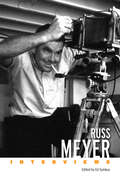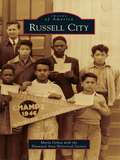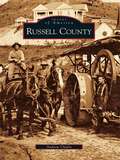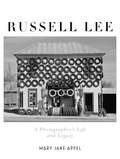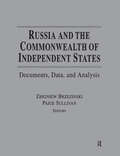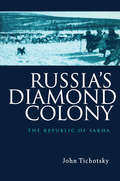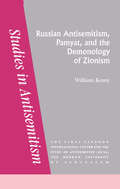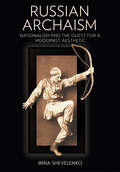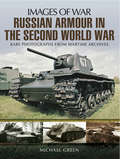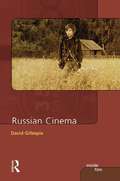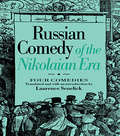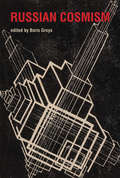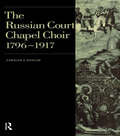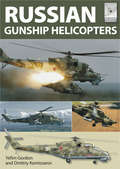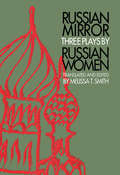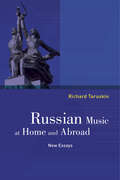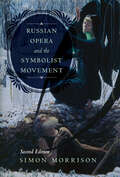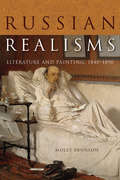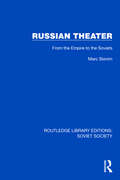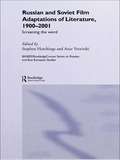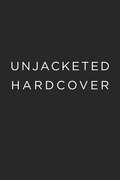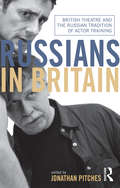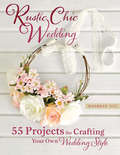- Table View
- List View
Russ Meyer: Interviews (Conversations with Filmmakers Series)
by Ed SymkusRuss Meyer: Interviews offers a detailed look into the mind, life, and successful career of the maverick filmmaker Russ Meyer. Known for his audacious visual style and boundary-pushing content, Meyer (1922–2004) carved out a unique niche in the film industry with his provocative and often controversial works, including Faster, Pussycat! Kill! Kill!; Beyond the Valley of the Dolls; and Vixen! In this volume, Meyer talks over the course of eighteen newspaper and magazine interviews—conducted between the late 1960s and early 1990s—about assignments in still- and motion-picture combat photography during World War II, learning all aspects of the filmmaking craft when he was shooting industrial films after the war, later stumbling into the business of photographing pin-up girls for magazines, and how that segued into his first forays in what would become the sexploitation movie market. Working with small budgets and small crews, Meyer became a skilled director and pitchman for his own work, hitting the road with reels of film in his car, going from town to town, getting them shown in small moviehouses, building an audience, making big profits, then using them to make his next film. The films were expertly photographed, inventively edited, and featured intriguing (and violent, carnal, and funny) storylines, and ticket sales numbers eventually caught the eyes of the Hollywood studio system, for which Meyer briefly worked, before once again striking out on his own with ever-more violent, sexual, and cartoonish features. Meyer made fortunes, he lost fortunes, then he made them again, and he was always game for getting involved in controversy, which was easy due to the content of his films. After his final theatrical feature—Beneath the Valley of the Ultra-Vixens—in 1979, Meyer reinvented himself as an entrepreneur by making his films available on the burgeoning home video market, leaving him a celebrated and very wealthy man.
Russell City
by Hayward Area Historical Society María OchoaBetween 1853 and 1964, on the western shore of what is now the city of Hayward, there existed a small rural community. This pictorial history traces the role that this region, which became known as Russell City, played in the development of the East Bay. Named for Joel Russell, a New England teacher who came to California during the Gold Rush and found success as a judge, political activist, and businessman, Russell City later became a destination point for diverse migrant and immigrant groups including Spaniards, Danes, Germans, Italians, African Americans, and Mexicans. While the economic means of the residents were never great, social riches abounded in the cultural and religious traditions that were practiced. A plan to create an industrial park on Russell City land emerged during the 1950s, and by 1964 the residents and businesses were entirely removed through eminent domain. An annual reunion picnic, begun in 1978, serves as a reminder of the community once built and then tossed to the winds. In the words of the former residents, "The city may be gone, but the memories live on."
Russell County (Images of America)
by Andrew ChafinRussell County was formed in 1786 from a portion of Washington County. It was named for Col. William Russell, who assisted in the drafting of the Declaration of Independence. Early settlers, who were mostly English and Scotch-Irish, endured geographic isolation as they shaped the ways of life, attitudes, products, legends, and realities that would ultimately usher Russell County into the information age of the 21st century. In 1774, Daniel Boone led the defense of the Clinch River settlements during Dunmore's War, the war between the colony of Virginia and the Shawnee and Mingo Indians. The Virginia-led attack was designed to remove the last obstacle to colonial conquest of the area. By 1858, Russell County had been reduced from 3,000 square miles to 483 square miles. Other counties formed from all or part of Russell were Lee, Tazewell, Scott, and Buchanan. A portion of what is now West Virginia was within the original boundaries of Russell County. The county seat, Lebanon, is a vibrant destination for industry and technology.
Russell Lee: A Photographer's Life And Legacy
by Mary Jane AppelRussell Lee, a contemporary of Walker Evans and Dorothea Lange, now emerges from the shadows as one of the most influential documentary photographers in American history. The most prolific photographer of the Great Depression, Russell Lee has never been canonized for his iconic images. With this compulsively readable and definitive biography, historian and archivist Mary Jane Appel finally uncovers Lee’s rebellious life, tracing his journey from blue-blood beginnings to intrepid years of activism and pioneering creativity, through the incredible body of work he left behind. Born in the quintessential turn-of-the-century small town of Ottawa, Illinois, in 1903, Lee grew up in a wealthy family riddled with tragedy. He trained in college to become a chemical engineer, but was quickly drawn to Greenwich Village, where he developed an interest in social change and the arts. In 1935, the charismatic bohemian picked up a camera and a year later walked into the office of Roy Stryker, head of the Historical Section of the Resettlement Administration, later renamed the Farm Security Administration (FSA), setting in motion a new life trajectory. The Historical Section aimed to capture rural poverty and the New Deal programs designed to abolish it. But Stryker imagined a much broader pictorial sourcebook for America, and no one on his legendary team—including Dorothea Lange, Walker Evans, and Gordon Parks, among others—would be more dedicated to reaching this goal than Russell Lee. As Appel demonstrates, Stryker and Lee developed a fascinating symbiotic relationship that resulted in a massive and complex breadth of work. Living out of his car from the fall of 1936 to mid-1942, Lee crisscrossed America’s back roads more than any photographer of his era. During this time, he shot 19,000 negatives that were captioned and printed—more than twice that of any other FSA photographer. He captured arresting images of sweeping dust storms and devastating floods, and chronicled the World War II home front and the last gasp of a small-town America that was inexorably vanishing?all the while focusing prophetically on issues like segregation and climate change, decades before they became national concerns. Meticulously weaving previously uneen letters and diaries, Appel brilliantly reveals why Lee’s profile has remained obscured, while his contemporaries became broadly celebrated. With more than 100 images spread throughout, Russell Lee speaks not only to the complexity of a pioneering documentary photographer’s work but to a seminal American moment captured viscerally like never before.
Russia and the Commonwealth of Independent States: Documents, Data, and Analysis
by Zbigniew K BrzezinskiThis work brings together major accords and protocols that form the institutional framework of the Commonwealth of Independent States (CIS); a selection of policy statements by the leaders of CIS countries; a chronological record of political, economic and military security developments and major crises in CIS "hot spots"; and statistics and country profiles.
Russia's Diamond Colony: The Republic of Sakha
by John TichotskyThis study looks at the reform process in Sakha and at a one hundred year history of economic development. The research revealed that Sakha's progress has always been determined by the export of key resources.
Russian Antisemitism Pamyat/De (Studies In Antisemitism Ser. #Vol. 2.)
by CoreyFirst Published in 1995. Routledge is an imprint of Taylor & Francis, an informa company.
Russian Archaism: Nationalism and the Quest for a Modernist Aesthetic (NIU Series in Slavic, East European, and Eurasian Studies)
by Irina ShevelenkoRussian Archaism considers the aesthetic quest of Russian modernism in relation to the nation-building ideas that spread in the late imperial period. Irina Shevelenko argues that the cultural milieu in Russia, where the modernist movement began as an extension of Western trends at the end of the nineteenth century, soon became captivated by nationalist indoctrination. Members of artistic groups, critics, and theorists advanced new interpretations of the goals of aesthetic experimentation that would allow them to embed the nation-building agenda within the aesthetic one. Shevelenko's book focuses on the period from the formation of the World of Art group (1898) through the Great War and encompasses visual arts, literature, music, and performance. As Shevelenko shows, it was the rejection of the Russian westernized tradition, informed by the revival of populist sensibilities across the educated class, that played a formative role in the development of Russian modernist agendas, particularly after the 1905 revolution. Russian Archaism reveals the modernist artistic enterprise as a crucial source of insight into Russia's political and cultural transformation in the early twentieth century and beyond.
Russian Armour in the Second World War: Rare Photographs From Wartime Archives (Images of War)
by Michael GreenThis WWII pictorial history of Russia&’s tanks and armored fighting vehicles provides a vivid look at the Eastern Front through rare wartime photographs.When Hitler&’s armies advanced into Russia, it was Stalin&’s tanks and armored fighting vehicles that finally pushed them back from the outskirts of Moscow. At the Battle of Kursk in the summer of 1943, the Soviet tanks and AFVs proved their effectiveness by defeating the cream of the Panzertruppen. From that point on, the tanks and armored fighting vehicles of the Red Army continued their offensive operations until they victoriously entered Berlin in April and May of 1945. In this fascinating pictorial history, military expert Michael Green provides historical images of the full range of Russian armor as well as exterior and interior color photos of preserved and restored tanks and AFVs from the period. This latest book in the Images of War series brings to life the Red Army&’s efforts to repel Hitler's Panzer Armies.
Russian Cinema (Inside Film)
by David C. GillespieRussian Cinema provides a lively and informative exploration of the film genres that developed during Russia's tumultuous history, with discussion of the work of Eisenstein, Pudovkin, Mikhalkov, Paradzhanov, Sokurov and others. The background section assesses the contribution of visual art and music, especially the work of the composers Shostakovich and Prokofev, to Russian cinema. Subsequent chapters explore a variety of topics: The literary space - the cinematic rendering of the literary text, from 'Sovietized' versions to bolder and more innovative interpretations, as well as adaptations of foreign classics The Russian film comedy looks at this perennially popular genre over the decades, from the 'domestication' of laughter under Stalin to the emergence of satire The historical film - how history has been used in film to affirm prevailing ideological norms, from October to Taurus Women and Russian film discusses some of the female stars of the Soviet screen (Liubov Orlova, Vera Alentova, Liudmila Gurchenko), as well as films made by male and female directors, such as Askoldov and Kira Muratova Film and ideology shows why ideology was an essential component of Soviet films such as The Maxim Trilogy, and how it was later definitively rejected The Russian war film looks at Civil War and Second World War films, and the post-Soviet treatment of recent conflicts in Afghanistan and Chechnya Private life and public morality explores the evolution of melodramas about youth angst, town and village life, personal relationships, and the emergence of the dominant sub-genre of the 1990s, the gangster thriller Autobiography, memory and identity offers a close reading of the work of Andrei Tarkovskii, Russia's greatest post-war director, whose films, including Andrei Rublev and Mirror, place him among the foremost European auteur film-makers Russian Cinema offers a close analysis of over 300 films illustrated with representative stills throughout. As with other titles in the Inside Film series it includes comprehensive filmographies, a thorough bibliography and an annotated further reading list. The book is a jargon-free, accessible study that will be of interest to undergraduates of film studies, modern languages, Russian language and literature, as well as cineastes, film teachers and researchers.
Russian Comedy of the Nikolaian Rea (Russian Theatre Archive Ser.)
by Laurence SenelickThese four Russian comedies were written during the reign of Nicholas I, a period of considerable repression and censorship. They represent the most popular genres of the period. Lensky's Her First Night was an immensely popular vaudeville which held the stage for years; Kozma Prutkov's Fantasy is a parody of vaudeville which was banned after one night. Turgenev's Luncheon with the Marshal is a comedy of manners about provincial life, and Saltykov-Schedrin's Pazukhin's Death is a satire of greed and corruption so savage that it was forbidden during the author's lifetime. This collection constitutes a remarkable comic spectrum which will assist in enlarging the English language repertoire with a set of newly available and hightly stageworthy scripts.
Russian Cosmism
by Boris GroysCrucial texts, many available in English for the first time, written before and during the Bolshevik Revolution by the radical biopolitical utopianists of Russian Cosmism. Cosmism emerged in Russia before the October Revolution and developed through the 1920s and 1930s; like Marxism and the European avant-garde, two other movements that shared this intellectual moment, Russian Cosmism rejected the contemplative for the transformative, aiming to create not merely new art or philosophy but a new world. Cosmism went the furthest in its visions of transformation, calling for the end of death, the resuscitation of the dead, and free movement in cosmic space. This volume collects crucial texts, many available in English for the first time, by the radical biopolitical utopianists of Russian Cosmism.Cosmism was developed by the Russian philosopher Nikolai Fedorov in the late nineteenth century; he believed that humans had an ethical obligation not only to care for the sick but to cure death using science and technology; outer space was the territory of both immortal life and infinite resources. After the revolution, a new generation pursued Fedorov's vision. Cosmist ideas inspired visual artists, poets, filmmakers, theater directors, novelists (Tolstoy and Dostoevsky read Fedorov's writings), architects, and composers, and influenced Soviet politics and technology. In the 1930s, Stalin quashed Cosmism, jailing or executing many members of the movement. Today, when the philosophical imagination has again become entangled with scientific and technological imagination, the works of the Russian Cosmists seem newly relevant. Contributors Alexander Bogdanov, Alexander Chizhevsky, Nikolai Fedorov, Boris Groys, Valerian Muravyev, Alexander Svyatogor, Konstantin Tsiolkovsky, Anton Vidokle, Brian Kuan Wood A copublication with e-flux, New York
Russian Court Chapel Choir: 1796-1917 (Music Archive Publications)
by Carolyn C. DunlopFirst Published in 2000. Routledge is an imprint of Taylor & Francis, an informa company.
Russian Culture and Theatrical Performance in America, 1891–1933
by Valleri J. HohmanBetween the 1890s and the 1930s, advancements in communication and travel encouraged widespread international cultural exchange, and Americans increasingly came into contact with Russian culture and theatrical performance. A number of factors, including emigration from Russia, world war, revolutionary activities in both Russia and the United States, and developments in modernism in the American theatre influenced the way those performances were received by American artists and audiences. Examining the work of impresarios, financiers, and the press as well as the artists themselves, Hohman demonstrates how a variety of Russian theatrical styles were introduced and incorporated into American theatre and dance.
Russian Gunship Helicopters
by Yefim Gordon Dmitriy KomissarovFeatures;* Profiles of iconic types such as the Mil MI-24 'Hind', the Mil-28 and the Kamov Ka-52 'Alligator'.* Summary of design histories and careers* Colour reference for paint schemes * Critical review of available kits* Over 180 colour and black and white illustrations, including 20 full colour side-views and a range of various 3-view line-drawings. With profiles of a host of exciting designs, accompanied by a descriptive narrative history of the various types, this volume combines practical information with reflective historical analysis, making for a visually rich volume providing modellers with all they need to know about the most exciting Russian Gunship helicopter designs and associated model kits.This edition deals primarily with the three principal attack helicopter types of the present-day Russian Army;The Mil MI-24 'Hind' otherwise known as 'the Flying Crocodile' has been produced in large numbers with many versions and variants produced. It has been supplied to a host of countries and seen considerable combat action in conflicts both in the Soviet Union and abroad. It still forms the backbone of army aviation in Russia and remains at the forefront of national exposure.The Mil-28 is a more contemporary type and is broadly the equivalent of the McDonnell Douglas AH-64 Apache. The Kamov Ka-52 'Alligator' NATO name 'Hokum-B' also features. This helicopter is in service with the Army and is entering service also with the Russian Navy. Well-illustrated histories and structural analyses are supplemented with detailed descriptions of the various plastic scale model kits which have been released, along with commentary concerning their accuracy and available modifications and decals. This level of detail and insight is sure to prove invaluable to a wide community of model-makers, both at home and overseas.
Russian Mirror: Three Plays by Russian Women (Russian Theatre Archive Ser. #Vol. 14.)
by Melissa T. SmithThe three playwrights presented together in this volume On the Road to Ourselves), Elena Gremina (Behind the Mirror) and Olga Mikhailova (Russian Dream). The selected plays contain many elements which will appeal to Western directors and audiences: well-drawn characters, engaging plots, lively wit. Central to the three plays selected in this volume is a complex interaction of Russian and Western value systems, a theme that becomes increasingly relevant for Russian audiences with each passing season and no less relevant for Europeans and Americans.
Russian Music at Home and Abroad: New Essays
by Richard TaruskinThis new collection views Russian music through the Greek triad of "the Good, the True, and the Beautiful" to investigate how the idea of "nation" embeds itself in the public discourse about music and other arts with results at times invigorating, at times corrupting. In our divided, post–Cold War, and now post–9/11 world, Russian music, formerly a quiet corner on the margins of musicology, has become a site of noisy contention. Richard Taruskin assesses the political and cultural stakes that attach to it in the era of Pussy Riot and renewed international tensions, before turning to individual cases from the nineteenth century to the present. Much of the volume is devoted to the resolutely cosmopolitan but inveterately Russian Igor Stravinsky, one of the major forces in the music of the twentieth century and subject of particular interest to composers and music theorists all over the world. Taruskin here revisits him for the first time since the 1990s, when everything changed for Russia and its cultural products. Other essays are devoted to the cultural and social policies of the Soviet Union and their effect on the music produced there as those policies swung away from Communist internationalism to traditional Russian nationalism; to the musicians of the Russian postrevolutionary diaspora; and to the tension between the compelling artistic quality of works such as Stravinsky’s Sacre du Printemps or Prokofieff’s Zdravitsa and the antihumanistic or totalitarian messages they convey. Russian Music at Home and Abroad addresses these concerns in a personal and critical way, characteristically demonstrating Taruskin’s authority and ability to bring living history out of the shadows.
Russian Opera and the Symbolist Movement, Second Edition (California Studies In 20th-century Music Ser. #2)
by Simon MorrisonAcclaimed for treading new ground in operatic studies of the period, Simon Morrison’s influential and now-classic text explores music and the occult during the Russian Symbolist movement. Including previously unavailable archival materials about Prokofiev and Tchaikovsky, this wholly revised edition is both up to date and revelatory. Topics range from decadence to pantheism, musical devilry to narcotic-infused evocations of heaven, the influence of Wagner, and the significance of contemporaneous Russian literature. Symbolism tested boundaries and reached for extremes so as to imagine art uniting people, facilitating communion with nature, and ultimately transcending reality. Within this framework, Morrison examines four lesser-known works by canonical composers—Pyotr Tchaikovsky, Nikolay Rimsky-Korsakov, Alexander Scriabin, and Sergey Prokofiev—and in this new edition also considers Alexandre Gretchaninoff’s Sister Beatrice and Alexander Kastalsky’s Klara Milich, while also making the case for reviving Vladimir Rebikov’s The Christmas Tree.
Russian Realisms: Literature and Painting, 1840–1890 (NIU Series in Slavic, East European, and Eurasian Studies)
by Molly BrunsonOne fall evening in 1880, Russian painter Ilya Repin welcomed an unexpected visitor to his home: Lev Tolstoy. The renowned realists talked for hours, and Tolstoy turned his critical eye to the sketches in Repin's studio. Tolstoy's criticisms would later prompt Repin to reflect on the question of creative expression and conclude that the path to artistic truth is relative, dependent on the mode and medium of representation. In this original study, Molly Brunson traces many such paths that converged to form the tradition of nineteenth-century Russian realism, a tradition that spanned almost half a century—from the youthful projects of the Natural School and the critical realism of the age of reform to the mature masterpieces of Tolstoy, Fyodor Dostoevsky, and the paintings of the Wanderers, Repin chief among them. By examining the classics of the tradition, Brunson explores the emergence of multiple realisms from the gaps, disruptions, and doubts that accompany the self-conscious project of representing reality. These manifestations of realism are united not by how they look or what they describe, but by their shared awareness of the fraught yet critical task of representation. By tracing the engagement of literature and painting with aesthetic debates on the sister arts, Brunson argues for a conceptualization of realism that transcends artistic media. Russian Realisms integrates the lesser-known tradition of Russian painting with the familiar masterpieces of Russia's great novelists, highlighting both the common ground in their struggles for artistic realism and their cultural autonomy and legitimacy. This erudite study will appeal to scholars interested in Russian literature and art, comparative literature, art history, and nineteenth-century realist movements.
Russian River
by Valerie A. Munthe John C. SchubertThe Russian River region has morphed from a lumber area, to a recreational paradise, to a retirement locale and a semi-bedroom community of Santa Rosa Valley, all the while sustaining itself as one of Northern California's premier vacation destinations. Each resort region town has its own personality dictated by its environment: forest, river, fields, and hills. A self-proclaimed "River Rat," Valerie A. Munthe has lived 20 years in Guerneville, where she and her husband, Jesse, raise their two children. John C. Schubert, who has lived on the Russian River for 55 years, is a former U.S. Marine, a retired deputy, and a local writer and historian of some note.
Russian Theater: From the Empire to the Soviets (Routledge Library Editions: Soviet Society)
by Marc SlonimRussian Theater (1963) is a comprehensive study of the main trends in Russian theatre in the nineteenth and twentieth centuries. Beginning with its origins in pagan folklore and ritual, it goes on to consider the romantic drama which flourished in the first half of the nineteenth century, the realistic drama of Gogol, Turgenev and their contemporaries, and the beginning of the modernist movement. The foundation of the famous Moscow Art Theatre in 1898 by Stanislavsky and Danchenko led to a remarkable period of innovation in acting, production and stage design which still influences the theatre of the West. Their association of Chekhov and their production of his plays is fully described. The reader is also introduced to the work of such playwrights as Andreyev and Gorky, and to the experiments and ideas of directors like Meeyerhold, Tairov and Vakhtangov. A large part of the book is devoted to a systemic analysis of plays and trends under the Soviets and the rise and fall of the avant-garde theatres and the reasons for their replacement by conservative realism.
Russian and Soviet Film Adaptations of Literature, 1900-2001: Screening the Word (BASEES/Routledge Series on Russian and East European Studies #Vol. 18)
by Stephen Hutchings Anat VernitskiProviding many interesting case studies and bringing together many leading authorities on the subject, this book examines the importance of film adaptations of literature in Russian cinema, especially during the Soviet period when the cinema was accorded a vital role in imposing the authority of the communist regime on the consciousness of the Soviet people.
Russian and Soviet Views of Modern Western Art: 1890s to Mid-1930s
by Ilia DorontchenkovIntroducing a wealth of little-known material set in an illuminating interpretive context, this sourcebook presents Russian and Soviet views of Western art during this critical period of cultural transformation. The writings document complex responses to these works and ideas before the Russians lost contact with them almost entirely.
Russians in Britain: British Theatre and the Russian Tradition of Actor Training
by Jonathan PitchesFrom Komisarjevsky in the 1920s, to Cheek by Jowl’s Russian ‘sister company’ almost a century later, Russian actor training has had a unique influence on modern British theatre. Russians in Britain, edited by Jonathan Pitches, is the first work of its type to identify a relationship between both countries’ theatrical traditions as continuous as it is complex. Unravelling new strands of transmission and translation linking the great Russian émigré practitioners to the second and third generation artists who responded to their ideas, Russians in Britain takes in: Komisarjevsky and the British theatre establishment. Stanislavsky in the British conservatoire. Meyerhold in the academy. Michael Chekhov in the private studio. Littlewood’s Theatre Workshop and the Northern Stage Ensemble. Katie Mitchell, Declan Donnellan and Michael Boyd. Charting a hitherto untold story with historical and contemporary implications, these nine essays present a compelling alternative history of theatrical practice in the UK.
Rustic Chic Wedding: 55 Projects for Crafting Your Own Wedding Style
by Morgann HillRustic Chic Wedding is a bride and groom's peek into the vintage-inspired, timeless wedding of their dreams. A little DIY with a whiff of romance and whimsy goes a long way toward wedding-day magic.Choose from any of the three beautiful wedding "themes.” Maybe your wedding style is Shabby Vintage Couture Wedding: try the Garden Table Numbers or Monogrammed Cake Stand. Or if the Rustic, Recycled & Re-purposed Wedding is more your speed, there's a Flower Girl Crown and Kissing Bell. The Urban Farmhouse Wedding has instructions for creating a Twig Cake Topper and a S'mores Bar. However you mix and match the projects, your wedding will express your love story, inside and out!With a chapter on creating the perfect themed tablescape and one dedicated to beautiful bridal bouquets and boutonnieres, Rustic Chic Wedding will be an indispensable guide on the sweetest day of your life..
